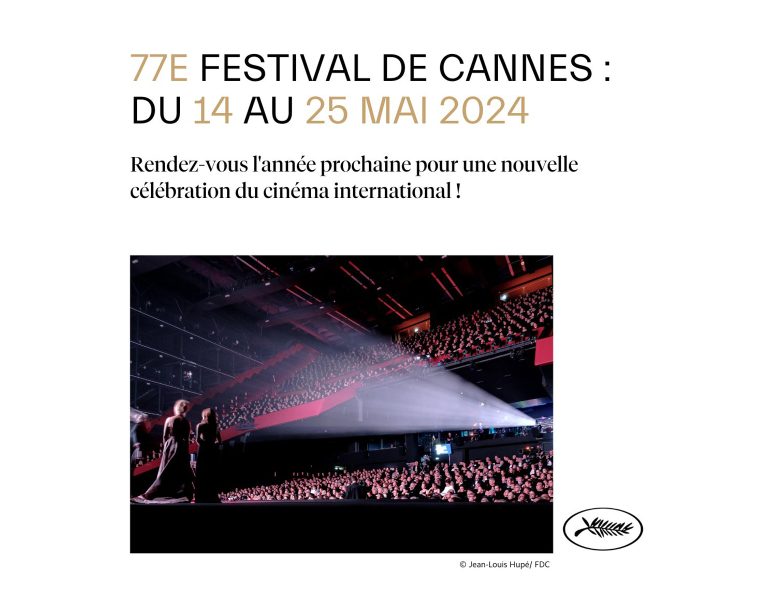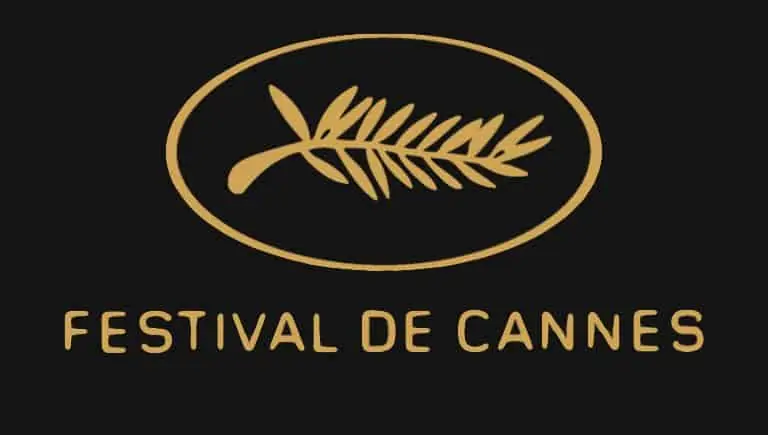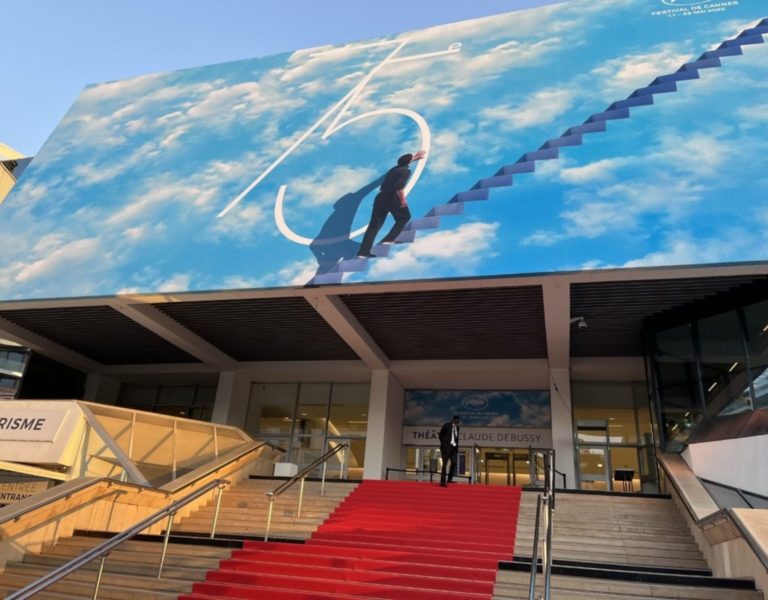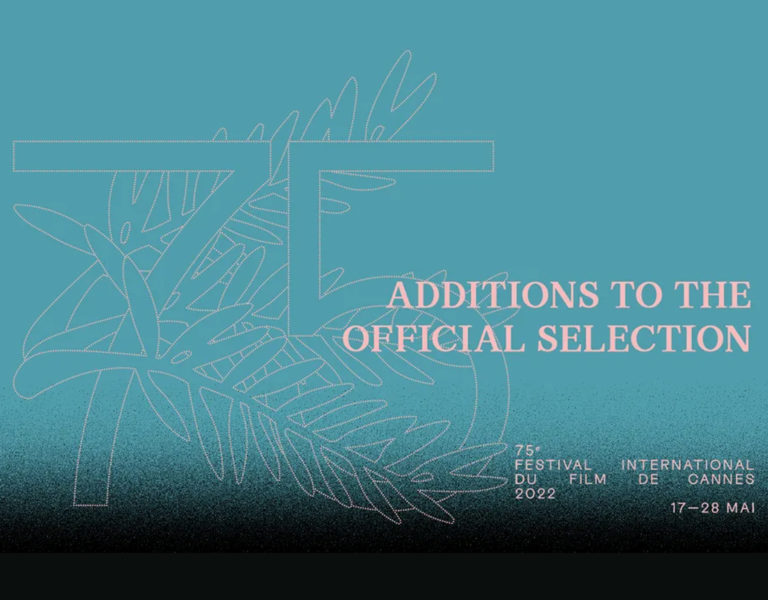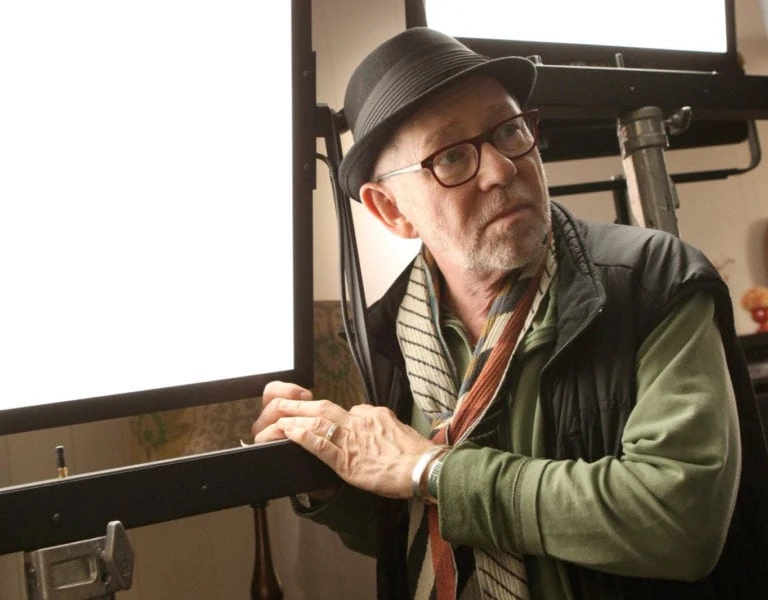CANNES I KICK IT?
From discovering the next generation of shooting stars and immersive tech through to celluloid celebrations and cinematic masterclasses, the magic of movies was in full force on the Croisette.
This year’s Cannes began with the threat of strikes, as French workers including projectionists planned to pull the plug on the 77th edition of the world’s most famous film festival. There were also rumblings in the media of a takedown of several high-profile male actors and directors, as the French film industry finally looked to be having its #MeToo moment. That neither really materialised meant, for better and worse, it was business as usual in Cannes.
Like last year’s Jeanne du Barry, the festival opened with a French movie. The Second Act is the latest from the prolific writer-director Quentin Dupieux (Deerskin, Mandibles). Starring Léa Seydoux, Louis Garrel and Vincent Lindon, this was another absurdist comedy. A meta-movie set around the making of a film (originally titled To Our Beautiful Profession), this self-aware, dialogue-heavy tale sees the cast all playing actors. Dupieux – who was also cinematographer on the film – even amusingly addresses the hot-button topic of artificial intelligence, and in particular the way the film industry is in danger of succumbing to this new technology.
When it came to cinematography, the startling black-and-white images captured by Michal Dymek PSC stood out in Magnus von Horn’s immaculate period piece, The Girl With The Needle. Inspired by a true story, Vic Carmen Sonne plays a factory worker in 1919 Copenhagen who falls pregnant and forms a bond with a woman (Trine Dyrholm) who runs a clandestine adoption agency. Drawing from the tropes of horror as well as silent cinema, von Horn’s competition entry was surprisingly overlooked by the jury but will surely find favour with audiences upon release. Other titles causing a stir on the Croisette included the out of competition gala screening and world premiere of George Miller’s Furiosa: A Mad Max Saga, which you can read about in this issue’s cover story interview with cinematographer Simon Duggan ASC ACS.
By the time the second week rolled around, the eventual Palme d’Or winner revealed itself in the shape of Sean Baker’s Anora. The raucous comedy-drama tells of a Brooklyn lap dancer (Mikey Madison) who marries one of her clients, the son of a Russian oligarch, in a match that soon spirals into chaos. Energetically shot by Drew Daniels, the Texas-born cinematographer on Baker’s last film, 2021’s Red Rocket, it touched on a major theme of the festival – female empowerment. Films like Jia Zhang-ke’s Caught By The Tides and the aforementioned The Girl With The Needle similarly foregrounded strong female characters.
Anora marked Baker’s second time in the competition after Red Rocket, and the win amounted to the realisation of what he said has been his “singular goal as a filmmaker for the past 30 years”. Announcing the Palme d’Or, Cannes jury president Greta Gerwig said, “This particular film, this incredibly human and humane film that captured our hearts, made us laugh, let us hope beyond hope and then broke our hearts and never lost sight of the truth.”
Baker in his acceptance said he was “shaken” and “still in disbelief” that the festival “invited our little baby to the ball. I’m going to fight for cinema because right now as filmmakers we need to fight to keep cinema alive. This means making feature films intended for theatrical exhibition. The world has to be reminded that watching a film at home while scrolling through your phone checking emails and half paying attention is just not the way – although some tech companies would like us to think so. Watching film with others in a movie theatre is one of the great communal experiences, we share laughter, sorrow, anger, fear and hopefully have a catharsis with our friends and strangers – and that’s sacred. So I say the future of cinema is where it started, in a movie theatre”.
Following the win, Anora DP Drew Daniels shared insight into their creative process: “Sean and I both have an obsessive level of commitment to the film and that obsession and love of cinema translates directly into the filmmaking process. We both tend to like the same kinds of films, and when we’re working together we’re very aligned. I spend a great deal of time with him scouting and driving around in cars and he usually assigns a list of films he likes for various reasons that I can feed off of.
“At this point I have a good idea of what Sean’s sensibilities are and they’re very similar to mine so the mind reading process is becoming easier and easier. One of the most important things is that Sean gives me many ideas and concepts that I can easily sink my teeth into and as a DP, that’s exactly what I’m looking for in a director.”
Movie magic
Meanwhile, All We Imagine as Light – the first Indian film in the Official Competition at the festival in 30 years and one of only four films in the competition directed by a woman – went on to scoop the Grand Prix. Written and directed by Payal Kapadia and shot by Ranabir Das, it is a portrait of two women negotiating their careers and love affairs in modern day Mumbai.
Jacques Audiard’s lauded Emilia Perez (Cin: Paul Guilhaume AFC) received a shared Best Actress nod for its female ensemble of Adriana Paz, Zoe Saldana, Karla Sofia Gascon and Selena Gomez as well as the Jury Prize. The film – a musical about a lawyer who helps a gangster retire from his business and disappear by becoming a woman – garnered among the longest standing ovations when it was presented.
One of the most rapturous applauses we experienced in the festival’s press screenings followed Coralie Fargeat’s body horror, lensed by Benjamic Kračun BSC, The Substance. The film – which was in competition and scooped Best Screenplay – stars Demi Moore as a fading celebrity who resorts to using a black market cell-replicating substance that temporarily creates a younger, better version of herself (in the form of a character played by Margaret Qualley).
Kračun shared insight into shooting the wild, weird and wonderful production with us: “There are so many fascinating visual ideas from birthing a new you from your spine, to the full on operatic blood ending. The script only had around 29 pages of dialogue so it was extremely visual – the camera and style, the macro shots. The fact that it was going to be shot in camera over VFX and using prosthetics make-up provided an array of enticing challenges to take on.”
To create the singular universe he used pop colours, seductive camera moves, and allusions to other iconic films worked to create this singular universe. Kračun also turned to a lot of traditional techniques such as soft drops outside windows, tungsten lights, vintage lenses and mixed that with much more modern techniques, wide angles, macro shots, and top shots. “The world of The Substance serves as a kind of Hollywood of the mind and a place which feels and looks seductive, yet is utterly disgusting underneath,” he said. “A kind of pink noir, if you like.”
Paolo Sorrentino’s indulgent Parthenope, starring Celeste Dalla Porta in the title role, tells the story of a beautiful woman who becomes an anthropologist. The Italian director behind the Oscar-winning The Great Beauty arguably skated close to self-parody here, with a film that languorously idolises its female protagonist. The lush images of Naples and the Mediterranean were captured by the film’s DP, Daria D’Antonio. The CST Artist-Technician prize was awarded to D’Antonio for the “grace and beauty” of the cinematography. The 2024 jury awarded the CST Young Technician Prize to Evgenia Alexandrova, cinematographer on Noémie Merlant’s The Balconettes, “for the quality of her photography, with its saturated colours and assertive lighting direction that transports us from comedy to genre film”.
Veteran filmmaker, David Cronenberg, returned to the competition line-up with The Shrouds (Cin: Douglas Koch CSC), a film about grief inspired by the Canadian director’s wife, who died in 2017 from cancer. In the film, Vincent Cassel plays a widower who sets up a cemetery with advanced technology, allowing mourners to observe the decaying corpses of their loved ones.
One of the last films to play in competition was The Seed of the Sacred Fig (Cin: Pooyan Aghababaei), a powerful three-hour drama about a father whose work for the Iranian authorities puts him in direct conflict with his family. The jury gave director Mohammad Rasoulof a Special Award, undoubtedly in recognition of his own bravery. The filmmaker fled Iran in May when he learnt that he was due to be sentenced to eight years in prison, following the same fate as many creatives in the region. At an emotional press conference in Cannes, the 51-year-old director questioned the Islamic Republic, “What are they really afraid of? Why are they so afraid of the stories we tell in our films? They try to repress independent cinema.”
Also gaining considerable attention was American indie Gazer, which was unveiled in the Director’s Fortnight strand. Directed by Ryan J. Sloan, who co-wrote the script with his wife and lead actress Ariella Mastroianni. This noir-like tale, lensed by Matheus Bastos, tells of a single mother who suffers from dyschronometria, a condition that means she cannot experience time perception. Recalling Christopher Nolan’s early work, Gazer was shot over two years, with Sloan self-financing the project through his work as an electrician. It had left the couple stricken, financially. “We just found out that our electricity got turned off in our apartment, so we don’t know what we’re going home to,” he revealed during Cannes. “That’s where we’re at financially.”
Among the cinematographers British Cinematographer caught up with at the festival was Mihai Mălaimare Jr. ASC, DP on Francis Ford Coppola’s in competition Megalopolis – a Roman epic fable set in an imagined modern America which has been 40 years in the making. Mălaimare commented on his 19-year working relationship with Coppola: “I like challenges and he likes to do things that were never done before and are different so because we both enjoy that it’s the perfect collaboration. Working together for so long, we’ve established a certain visual style.”
We also enjoyed a lively and enlightening conversation with cinematographer Andrew Wonder following the screening of the in competition film he lensed, Paul Schrader’s Oh, Canada. The film stars Richard Gere as Leonard Fife (and Jacob Elordi as a younger Leonard), one of the draft evaders and deserters who fled to Canada to avoid serving in Vietnam.
“It’s my first time at Cannes and to be in a place where film is art and to be in the theatre and on the steps where so many of my heroes have climbed before is a dream that surpasses anything I’ve ever let myself dream before,” said Wonder, who, in honour of Jean-Luc Goddard, used a Beaulieu camera to capture his red carpet experience on a roll of Super 8 at the film’s premiere.
“To be here with my first film with my favourite collaborator is life changing. I’m so grateful to Paul Schrader, he’s been a mentor for almost half my life. When this film came up it was a different format for him with all the time periods and I felt honoured when he asked me how I would approach it. I asked him why he wanted me to do this film with all the people that were available to him and the answer was simple – he trusted me.”
Film in focus
The festival featured a strong showing for the UK with 12 works across the selection, including the world premieres of eight feature films. One of the UK productions was Andrea Arnold’s Bird (lensed by Robbie Ryan BSC ISC) which screened in competition, marking Arnold’s fifth feature film to premiere at the festival. Also in competition were two UK-US co-productions; Yorgos Lanthimos’ latest work Kinds of Kindness (also shot by Ryan) and The Substance (Cin: Benjamin Kračun BSC).
Three UK co-productions featured in Un Certain Regard: Sandhya Suri’s Santosh; Ariane Labed’s September Says; and Rungano Nyoni’s On Becoming a Guinea Fowl (with the latter picking up a joint Best Director short film prize). Screening in the Directors’ Fortnight were Sister Midnight from writer-director Karan Kandhari and To A Land Unknown, a co-production between UK, France, Germany, The Netherlands, Greece, Qatar, Saudi Arabia and Palestine.
Outside of the screening rooms and press conferences, festival-goers enjoyed a varied and packed programme of talks and seminars. Among the highlights was the educational line-up at the UK Pavilion which boasted sessions including a talent talk with Santosh writer-director Sandhya Suri, producer Mike Goodridge and director of BBC Film Eva Yates.
Speaking about transitioning from documentary into fiction, Suri said: “There was no career move, it was just that I was looking at a certain subject matter [violence against women] and I was working with some NGOs in India, looking at documentary research. Every time I looked into how to make a documentary, it became very frontal and direct and I knew that wasn’t the way I wanted to explore it, so I knew I had to somehow come from inside the violence.”
It was standing-room only at another UK Pavilion Screen Talk in which Robbie Ryan BSC ISC explored his work in multiple forms and long-standing relationships with directors Yorgos Lanthimos and Andrea Arnold. “We struck up the visual language right from the beginning with Wasp,” Ryan said about working with Arnold. “Andrea doesn’t like tripods so she always said we’re going to do handheld and I like that. I don’t know if she was testing me, but when we did the first day of shooting of Wasp she said, ‘Can you run down this set of council estate stairs backwards?’ And I said, ‘I’ll give it a go.’ I didn’t fall over and she said, ‘That’s pretty good.’
“Her style is really interesting… every film she’s done has had the exact same approach visually and it’s just the story is different each time. It’s simple, it follows a rule book I guess, but it always feels fresh.”
The Citizenship Award at Cannes was presented to Arnold’s Bird with the jury commending the film’s “cinematographic gesture sustained by poetry and humanism, with a punk energy that elevates human beings to the beauty and love of each other.”
Over at the festival’s Cannes Next Innovation Studio we spoke to Lucas Tucknott and Nils Pauwels – co-founders of the Institute of Immersive Media (IIM) – about the programme they curated which included two days of hands-on workshops featuring around 60 speakers sharing insight on the latest technology for creatives and filmmakers.
“This year’s Innovation Studios features a lot about AI as well as virtual production. We’re also organising the Future of Entertainment and Virtual Production Summit on the main stage in the Palais,” Tucknott shared at one of the Innovation Studio’s networking sessions. “Cannes is the heart of filmmaking and such a unique place. For us to bring technology in this way and to this setting, where it’s not traditionally had a place, is really exciting for us.”
Other tech-related triumphs included Dolby celebrating 50 years in film and Ioan Allen, senior vice president at Dolby, being awarded a Festival de Cannes Medal by Thierry Frémaux, general delegate of the Festival de Cannes and managing director of the Institut Lumière. Dolby also announced the famous Louis Lumière room in the Palais des Festivals – which hosts the official Cannes preview screenings – will be transformed to incorporate Dolby Atmos immersive sound for 2025.
Winning spirit
Aside from the short and feature film winners, a plethora of other individuals and associations were celebrated including those excelling in sustainability at the Global Production Awards. Green winners included Bristol (City of Film); Film AlUla, Saudi Arabia (Emerging Location Award); Sunset Studios (Studio of the Year); True Detective: Night Country (Sustainable Production Award, Scripted); and BAFTA albert (Special Recognition Award).
Women In Motion welcomed prominent female figures of the cinema and entertainment industries – including included actress and producer Julianne Moore; actress and producer Cate Blanchett; actress Zoe Saldaña, actress; and chairman, NBCUniversal Studio Group and chief content officer, Dame Donna Langley – to its Talks series to discuss their views on women’s representation and diversity in cinema, arts and culture. Langley also received the Women in Motion Award.
Others celebrated at the festival included Japanese animation studio, Studio Ghibli, which received the Honorary Palme d’Or. And in a moving reunion that concluded Cannes 2024 in style, director, producer and screenwriter George Lucas was presented with an Honorary Palme d’Or by longtime collaborator Francis Ford Coppola. “The Festival de Cannes has always held a special place in my heart,” said Lucas. “I was surprised and elated when my first film, THX-1138 [which Coppola helped him produce], was selected to be shown in a new programme for first time directors called the Directors’ Fortnight. Since then, I have returned to the festival on many occasions in a variety of capacities as a writer, director and producer. I am truly honoured by this special recognition which means a great deal to me.”
Filmmaking talent was also celebrated at the Pierre Angénieux Tribute ceremony. This year’s award was presented to Indian cinematographer Santosh Sivan ASC ISC, who also delivered a masterclass at the festival (read about Sivan’s career in an interview on p18)
Sivan said he owed his “gratitude to a lot of people, but most importantly I must thank the state of Kerala whose culture I imbibed through my father and my grandmother. And it is there, in the Malayalam film industry, that I learnt the basics. Of course, cinematography is an art without language or rather has a universal language. From Kerala I shifted to Tamil cinema, then to the Hindi film industry and then to Hollywood. What is great about this profession is that it has no boundaries.”
Angénieux also continued to highlight the work of up-and-coming filmmakers by presenting the Angénieux Special Encouragement award to Estonian cinematographer Kadri Koop.
Cinematic gatherings
Away from the films, the Cannes social scene was in full swing too. We enjoyed catching up with filmmakers and industry friends and making new connections at events organised by Sony, Kodak, ARRI, Women in Film and TV, and Girls on Film, among others.
Anna Smith, host and co-founder of the Girls on Film podcast, shared her 2024 Cannes experience when we spoke with her at the Girls on Film event. “I love Cannes – I can see a couple of films a day and file for different magazines and newspapers. Some films are great and some are not so great. While there have been quite a lot of two out of five star films for me this year – some of them for feminist reasons – there have also been some really strong women-centred films such as The Girl with the Needle, On Becoming a Guinea Fowl, and Bird.”
This year’s Cannes was triumphant for productions shot on film, with 33 titles shot on celluloid across the festival, including Palme d’Or (Anora); Best Director (Miguel Gomes for Grand Tour); Best Actor (Jesse Plemons for Kinds of Kindness); and Best First Film/Caméra d’Or (Armand) along with four winners in Critics’ Week and the winner of the inaugural Audience Award in Directors’ Fortnight. At Kodak’s celebration of film on film at the American Pavilion we chatted to Cannes newbies and festival veterans about their experiences.
Robbie Ryan BSC ISC – whose two films in competition were shot on film – was one of the guests flying the flag for celluloid and highlighting the increasing number of in competition productions shot on film. “Shooting on film is essential… and I think analogue films are becoming a lot more achievable and people are realising they look better,” said Ryan, who considers Cannes to be “the pinnacle of festivals for showing your film.”
He also advises up-and-coming filmmakers “get a Bolex because they’re quite cheap and very good cameras. Just go out and film loads of stuff and experiment because they’re the best cameras to experiment with”. He also suggests “getting friendly with a laboratory and seeing if they’ll do some free processing and scanning for you. You’ll be hooked and you’ll always want to shoot on film”.
For Michael Beaven, deputy CEO, Production Guild of Great Britain, “the last three or four years of Cannes have been even more enjoyable as it’s felt even more supportive”. Among his hopes for the industry’s future is seeing everyone “be more respectful in what they do in film and television, whether it is sustainability, telling the correct stories or making sure the industry is supportive of its crew and cast. We also need to pay it forward, share our knowledge and support and learn from a new generation coming into the industry”.
One such up-and-coming cinematographer we met was Emils Spungis who is studying cinematography at The National Film School of Latvia. Commenting on his first Cannes experience, Spungis highlighted how impressed he was by “the number of new directors and producers he met” at the festival and events such as Kodak’s “and opportunities to discuss possible projects”.
Ed Sayers – filmmaker and founder of the Straight 8 competition that challenges filmmakers to shoot an entire film on one cartridge of Super 8mm cine film – had a reason to celebrate at the festival as it marked the 25th anniversary. His team was showing the top 8 in-camera edited Super 8 films in Olympia cinema at Cannes followed by showcasing the best 25 from this year’s competition in the IMAX in London.
“It’s not just poetic nonsense to say shooting on film adds something special, but everyone on set gets more excited about it when you’re running film,” Sayers told us at Kodak’s event. “It’s a finite substance and you’re using something up which puts everyone on their A game. When I see something shot on film, I relate to it in a stronger way.”
Another beautiful setting, the Forbes Villa, played host to Her Club Cannes, a joint initiative between several groups including Herflix, Female Film Club, and Yes She Cannes, the latter organised by Faith Elizabeth to empower more women to come to the festival as well as providing a valuable support network in the wake of MeToo. Attended by a lively mix of film talent, it was heartening to see up-and-coming directors like British filmmaker Lona Fontaine (Unperson) on the guest list. As is so often the case, Cannes proved the perfect platform to launch the next generation.
–
CANNES 2024 WINNERS
FEATURE FILMS
Palme d’Or Anora (Dir: Sean Baker, Cin: Drew Daniels)
Grand Prix All We Imagine as Light (Dir: Payal Kapadia, Cin: Ranabir Das)
Jury Prize Emilia Pérez (Dir: Jacques Audiard, Cin: Paul Guilhaume AFC)
Best Director Miguel Gomes for Grand Tour
Special Award Mohammad Rasoulof for The Seed of the Sacred Fig (Cin: Pooyan Aghababaei)
Best Performance by an Actor Jesse Plemons in Kinds of Kindness
Best Performance by an Actress Adriana Paz, Zoe Saldaña, Karla Sofía Gascón, and Selena Gomez in Emilia Pérez
Best Screenplay The Substance by Coralie Fargeat (Cin: Benjamic Kračun BSC)
SHORT FILMS
Palme d’Or The Man Who Could Not Remain Silent (Dir: Nebojša Slijepčević, Cin: Gregor Bozic)
UN CERTAIN REGARD
Un Certain Regard Prize Black Dog (Dir: Guan Hu, Cin: Weizhe Gao)
Jury Prize l’Histoire de Souleymane (Dir: Boris Lojkine, Cin: Tristan Galand)
Best Director Prize Roberto Minervini for The Damned and Rungano Nyoni
for On Becoming a Guinea Fowl
Youth Award Holy Cow (Dir: Louise Courvoisier – 1st film, Cin: Elio Balezeaux)
CAMÉRA D’OR
Caméra d’Or Prize Armand (Dir: Halfdan Ullmann Tøndel, Cin: Pål Ulvik Rokseth)
LA CINEF
La Cinef First Prize Sunflowers Were the First Ones to Know… (Dir: Chidananda S Naik, Cin: Suraj Thakur)
